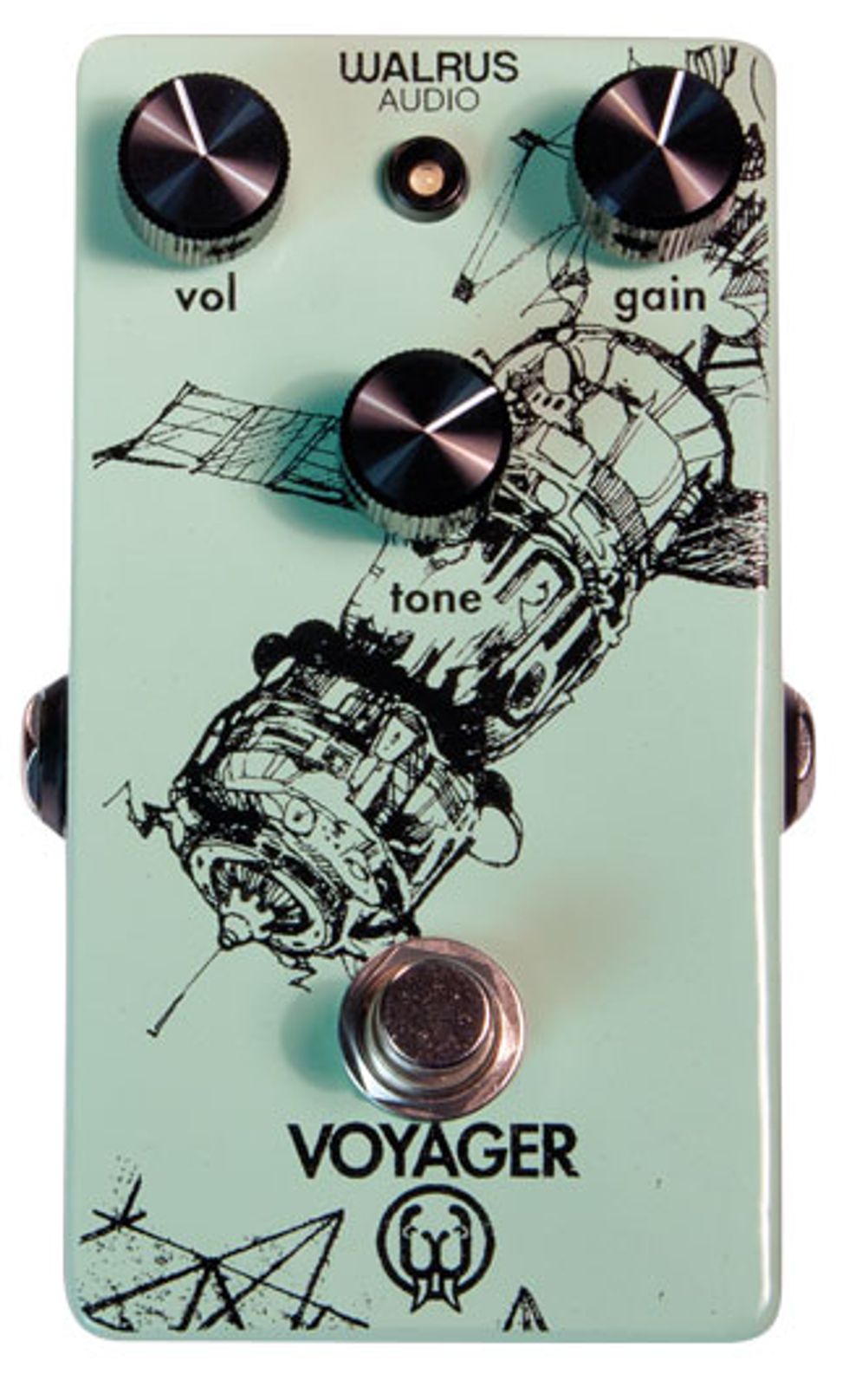A quality build that’s fit for a space program and tones that transcend the sounds of the classics.

There are a lot of parallels between space travel and getting a great, guitar tone. Both ventures are true exploration. Yet while the end result of both endeavors may be spectacular, reliability and utility are at the root of the equation. So it goes in your signal chain—if your magic flanger and reverse delay are the rocket’s roar, trail of flames at liftoff, and nebula image captured with your Hubble telescope—your overdrive is the nuts and bolts that keeps the rocket together.
With graphics representing the Russian Soyuz spacecraft, the Walrus Audio Voyager seems to acknowledge its humble role in a noble quest. But to confuse the fundamental nature of the Voyager’s task with ordinary would sell this pedal short. It’s an excellent overdrive that shines bright, possessing a quality build that’s fit for a space program and tones that transcend the sounds of the classics.
Mission Control
You can’t help but notice that Walrus
Audio’s Voyager is well made. Its heavy-duty
true-bypass switch makes a nice, mechanical
clicking sound when engaged but remains
inaudible through an amplifier. The white
LED indicator is super bright and can
cut through the thickest of stage fog. And
the 9V, Boss-style power-supply jack is
thoughtfully placed and recessed at just the
right depth to work with right-angle cables.
The control set is nothing complicated— just volume, gain, and tone—and the black, anodized-aluminum knobs exude quality. Nicely spaced for their size, their fluted sides make setting the controls a snap with your feet. And the potentiometers are extremely smooth, providing just the right amount of resistance. These thoughtful and practical touches, along with the mint-green powder-coat finish and cool graphics, suggest the creators have more than just a passing interest in design.
So what’s inside? Unlike a lot of classic overdrives, there are three op-amps covered by a clean coat of epoxy on top that obscures their model designation. Most classic pedals used one or two chips and some discrete transistors. Walrus Audio, however, uses modern chips and highprecision resistors on the heavy-duty circuit board. And there’s just one box capacitor inside the Voyager—which may be due to space constraints. To most ears, box capacitors tend to have a cleaner sound than traditional poly caps and a smoother sound compared to the electrolytic caps you’ll see in, say, a vintage Super-Fuzz. This is great in some applications, but not always desirable for a distortion or gain box, so it’s interesting that Walrus opted for them here. That said, this could ultimately be a key to the pedal’s range and agreeable nature.
The Stars Aligned
I tested the Voyager (along with my US
Lonestar Stratocaster and blackface Twin
Reverb) in the real-world crucible of a West
Coast tour—which means I got to evaluate
both the Voyager’s stand-alone capabilities
and the remarkable ways it interacted with
other effects on my pedalboard. On both
counts, the Voyager excelled.
One of the most remarkable things about the Voyager is the breadth of the pedal’s capabilities, and how that range enables it to stand in for other effects. In a normal performance situation, I’ll use a distortion pedal (with gain down and volume up) as a clean boost and a cocked wah as a treble boost. With the Voyager in the line, I didn’t need the wah or distortion at all. Walrus Audio’s overdrive gave me more than enough bite to cut through a dense mix and the boost significantly improved note articulation.
Ratings
Pros:
Super-wide frequency range. Focused tones. Topquality
build and components.
Cons:
The almost-overbuilt quality level drives up the cost
of admission.
Tones:
Playability/Ease of Use:
Build:
Value:
Street:
$189
Walrus Audio
walrusaudio.com
Just as revealing was the way it interacted with an MXR Blue Box. My old Blue Box can be tricky and chaotic—it’ll induce volume drops, track weirdly when picking too hard, completely overwhelm my speakers with low end, and lose upper harmonics. With the Voyager following directly after the Blue Box, it was like placing a studio EQ and compressor in my signal chain. The Blue Box/Voyager tandem cut through the stage mix, the harmonics were enhanced, the low end didn’t smother the output, and the Blue Box took on an entirely new dynamic dimension.
To test the Voyager in a stand-alone environment, I used a Gibson Firebird loaded with P-90s going through a Vox AC4TV and the Fender Twin Reverb. At low volumes, the Voyager made it easy to get a more defined and cutting tone than with just the amp and guitar. But even with a boost in treble and gain, the tone from the P-90s remained balanced and concise with plenty of harmonics spread throughout the frequency range.
By cranking the tone up to 5 o’clock, I got to a punky snarl worthy of the Buzzcocks. Turning the knob back to its lowest reaches at 7 o’clock and then cranking the gain took me into smooth-but-raw, psychedelic Afro-beat territory. When I moved between these extremes, I realized how effectively I could switch from rhythm to lead textures. And while the pedal can easily be set up to occupy either role, it’s remarkable how well the Voyager happily occupies a middle ground between searing and sedate—often missing from more monochromatically voiced pedals.
The Verdict
The Walrus Audio Voyager is a workhorse
with more than a touch of Renaissance man
wired into the circuit. It fills the relatively
unglamorous roles of treble shaper and
booster, clean boost, overdrive, and distortion—
all with personality and a sonic and
dynamic range that can surprise. The build
quality is outstanding and it works exceedingly
well with other pedals. There’s a lot
more going on than meets the eye with
the Voyager, including the ability to give
your existing rig voices you never knew it
had. And that’s what the search for tone is
about—on this world or any other.
- Walrus Audio Unveils the Badwater Bass Preamp and D.I. - Premier Guitar ›
- Walrus Audio Launches the Lore Reverse Soundscape Generator - Premier Guitar ›
- Walrus Audio Unveils the Mira Optical Compressor - Premier Guitar ›
- Walrus Audio Fable Granular Soundscape Generator Delay Pedal - Premier Guitar ›
- Walrus Audio Fundamental Series - Premier Guitar ›
- Walrus Audio Fundamental Series Pedal Demos | NAMM 2023 - Premier Guitar ›
- Walrus Audio Canvas Passive Re-Amp - Premier Guitar ›
- Walrus Audio Slöer Ambient Reverb - Premier Guitar ›
- Walrus Audio Introduces 385 MKII Overdrive - Premier Guitar ›
- Walrus Audio Announces Canvas Tuner - Premier Guitar ›
- Walrus Audio Announces Silt Harmonic Fuzz ›
- Walrus Audio Fundamental Ambient ›


